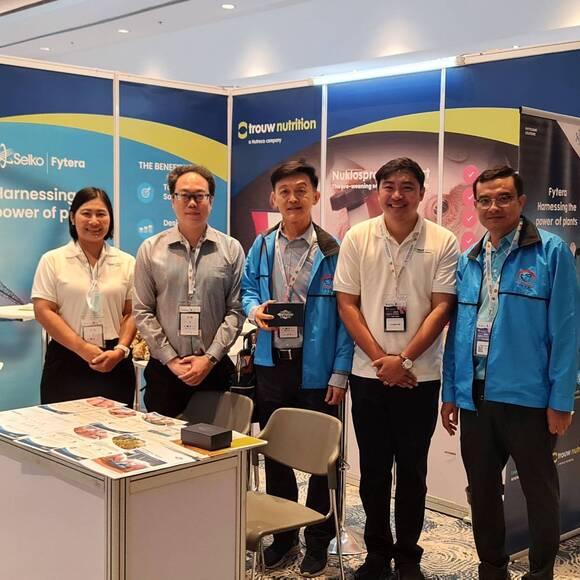Explore all the information on
Swine health
Pig diseases can be caused by bacteria, viruses, protozoa, nutritional deficiencies, poisonous substances, internal and external parasites.
Bacterial diseases include swine erysipelas, swine dysentery, infectious poly-arthritis etc. Viral and mycoplasma diseases include African swine fever, swine influenza, enzootic pneumonia of pigs, vesicular exanthema of swine, transmissible gastroenteritis etc. Helminthiasis as a health problem in pigs is mainly caused by worms like the lungworm, ascaris worm etc. Nutritional diseases include piglet anemia, parakeratosis etc. External parasitic infections include mange, lice, jiggers etc.
How to tell that a pig is in bad health:
General signs: dullness, loss of appetite, labored or rapid breathing, sudden deaths, loss of weight, low weight gain and fever usually manifested by shivering of the pig.
Signs expressed on the skin: reddening of the skin or skin discoloration, loss of hair and hardening of some parts of the skin, itching and cracking of the skin.
Other signs: lameness, cough, abnormal nasal discharges, diarrhea with a putrid smell, abnormal content and color of feces and abortions.
Introduction: PRRS is one of the most economically important viral diseases in swine industry. The genome of the causative virus encodes seven structural proteins, namely, GP2a, GP2b, GP3, GP4, GP5, M and N. Although the antibody response against N protein after the infection has been well investigated using an available kit, the antibody response against other structural proteins is yet to be evaluated. Here, except for GP2b, we evaluated by an immunofluorescence...
Comments : 0
Recommendations: 0
Introduction: The FAO (1999) estimates that at least 25 % of world grain and seed production is contaminated by fungi and their mycotoxins, and are considered as one of the greatest risks that affect human and animal health. The fumonisins have been associated with certain diseases in animals such as the leucoencefalomalacia in equines (ELEM) and pig lung edema (PLE). The porcine reproductive and respiratory syndrome (vPRRS) has economically impacted the national and...
Comments : 0
Recommendations: 0
Introduction: To offer routine diagnostic analyses that are cheaper and less time-consuming than our current in-house ELISAs, we have developed and evaluated a Luminex-based multiplexed immunoassay that facilitates simultaneous detection and distinction between antibodies to porcine reproductive and respiratory syndrome virus (PRRSV) Type 1 and Type 2, Actinobacillus pleuropneumoniae (App) serovars 2, 6 and 12 as well as Salmonella Typhimurium and Salmonella...
Comments : 0
Recommendations: 0
Introduction: Slaughter line observations can be included in breeding values of breeding pigs to enhance animal welfare. By monitoring lesions/remarks on joints, lungs, hearts and other parts of the carcasses, clear differences between farms and individual pigs can be demonstrated. Lesions like bursitis, pericarditis and pneumonia indicate lower welfare of the animals. Higher incidences of these lesions are associated with lower average daily gain. These lesions are...
Comments : 0
Recommendations: 0
Introduction: Body core temperature is an important clinical parameter for monitoring infections in mammals and can be measured with different devices. In practice rectal measurement is the standard method and equated to the body core. In order to investigate the constancy of the relationship between practical body core temperature (rectal) and abdominal temperature under physiological and pathophysiological conditions, we compared both devices in healthy pigs as well as...
Comments : 0
Recommendations: 0
Introduction: Clinician and pain researchers agree that there is a need for measures of pain. In pigs, being a species of prey, pain may be concealed and thus difficult to assess. However, identification of pain is necessary to enable its alleviation. Several physiological and behavioural parameters have been used in this respect during the last decades, however with only little success. A useful method must be able to distinguish pain-related changes from behaviours related to...
Comments : 0
Recommendations: 0


CreAMINO® supplementation improves growth performance and lean meat yield of pigs
Suggested link
Introduction: Body core temperature is a stable parameter under physiological conditions as well as an important cardinal symptom for clinical monitoring in systemic inflammation. Besides fever further indicators of an inflammatory reaction are changes in white blood cell counts, TNF-α and kynureninetryptophan ratio, but their interrelationship is not yet fully clarified. Thus we investigated these relationships in healthy as well as in pigs exposed to LPS and/or...
Comments : 0
Recommendations: 0
Introduction: The cross-contamination of non-medicated feed with residues of antimicrobials causes a public and animal health concern associated with the potential for selection and dissemination of resistance in commensal and potentially zoonotic bacteria. To identify the extent of the situation, we built a model that provides a way to estimate the percentage of cross-contaminated pig feed in total and per different levels at which cross-contamination may occur (i.e....
Comments : 1
Recommendations: 0
Jay Johnson (USDA) shared insights on heat stress and new technology, in this Swine It interview with host Laura Greiner....
Comments : 1
Recommendations: 1
Introduction: In situ hybridization (ISH) is a nucleic acid-based method that allows the detection of a particular RNA or DNA sequence within the tissue sections. A novel ISH RNA-based chromogenic technique (RNAScope) describes single-molecule visualization through the use of hybridization-based signal amplification system. These characteristics make this platform a promising diagnostic approach, especially by improving sensitivities issues faced by classical ISH...
Comments : 0
Recommendations: 0
Introduction: Actinobacillus pleuropneumoniae (APP) is the etiologic agent of porcine pleuropneumonia, a worldwide endemic and highly contagious disease with high economic impact. There are 2 biovars and 15 different known serotypes. APP that require nicotinamide adenine dinucleotide (NAD) for growth are designated as biovar 1 while APP isolates that are NAD independent are designated as biovar 2. In this study, the fed-batch fermentation process was optimized for...
Comments : 0
Recommendations: 0
Introduction: Pork head meat, cheek meat, lymph nodes, and other carcass by-products may become contaminated with Salmonella in pork slaughter facilities. In a preliminary survey, a large pork processing plant in the United States was sampled bimonthly from January to July of 2015 to determine the prevalence, seasonality, and serotype diversity of Salmonella enterica (SE) isolated from cheek meat and head trim of swine carcasses. Materials and...
Comments : 0
Recommendations: 0
Introduction: Porcine Respiratory Disease Complex (PRDC) is a multifactorial syndrome which is a source of heavy economical losses. Its control implies herd management and therapeutic measures (vaccines, antimicrobials). Objective of this study was to assess efficacy of a multivalent vaccine to prevent PRDC and related losses in a Philippine herd. Materials and Methods: The study was performed in a farrow-to-finish herd with1,400 sows having a history of...
Comments : 0
Recommendations: 0
Introduction: The use of antibiotic drugs in food producing animals is considered to be a major risk factor for selection of antimicrobial resistance in humans as well as in animals. All antibiotics used in veterinary medicine are closely related to the antibiotics used in human medicine and may induce cross-resistance. Hence, minimizing antibiotic usage and prudent use of antibiotics are two key points to minimize the development of antibiotic resistance. Antibiotics...
Comments : 0
Recommendations: 0
Trouw Nutrition Asia Pacific is excited to invite you to join us at the 8th International Symposium on Emerging and Re-emerging Pig Diseases (ISERPD) as we present at the poster session on the groundbreaking topic of "Plant Extracts Impact: Immunity Supplementing Sows for Improved Colostrum Quality and Offspring Performance." Our team of experts has been tirelessly working on this research, and we can't wait to share our findings with you.
Make sure to visit our booth during the event to...
Comments : 0
Recommendations: 3
Introduction: Worldwide there is growing concern about the increase of antimicrobial resistance. Antimicrobial resistance (AMR) could be considered as the result of (over)usage of antimicrobials (AMs) in human beings and animals. In order to reduce further increase of AMR the government of the Netherlands together with the livestock sectors and vets developed an action plan to reduce the use of AMs, in the assumption that reduction is associated with reduction in resistance. The...
Comments : 0
Recommendations: 0


CreAMINO® supplementation improves growth performance and lean meat yield of pigs
Suggested link
Introduction: Italy is a large pig producer and a system to monitor active ingredients (AIs) consumptions of veterinary medicinal products (VMPs) at farm level is needed. The aims of this study were to develop a tool to record these consumptions and to compare AIs usages with production losses, biosecurity levels and health statuses. Materials and Methods: A data collection software, an XML database and an interactive dashboard were developed...
Comments : 0
Recommendations: 0
Introduction: Easiness of injections is an important parameter for animal welfare and operators. This study was done to compare viscosity and syringeability of 5 florfenicol injectable solutions marketed in Mexico or Brazil, under laboratory conditions. Materials and Methods: One 40% florfenicol injectable solution (Maxflor® LA, Virbac) was compared to four 30% florfenicol injectable solutions. Viscosity was measured at ambient temperature and 5°C by...
Comments : 0
Recommendations: 0
Introduction: Mycoplasma hyopneumoniae is the primary agent involved in porcine enzootic pneumonia (EP). Different genotypes of M. hyopneumoniae have been described using Multiple Locus Variable-number Tandem Repeat Analysis (MLVA). In our experience it is difficult to perform a MLVA from nasal swab samples due to the sensitivity of some PCRs. In this regard, we have reported the increasing of the sensitivity of p146 locus (Tamiozzo 2011, 2013) developing a...
Comments : 0
Recommendations: 0
Introduction: Multiple Locus Variable Tandem Repeat Analysis (MLVA) is a useful method to characterize bacterial strains and understand the transmission chains and sources of infection in order to implement more effective control measures. The present study is aimed to use MLVA technique to characterize M.hyopneumoniae (M.hyo) strains in pigs from wean to finish in the same herd. Materials and Methods: The study was carried out in a three-site herd in...
Comments : 0
Recommendations: 0









.jpg&w=3840&q=75)









